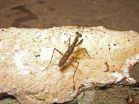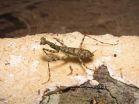(Press-News.org) A scientist has discovered 19 new species of praying mantis from Central and South America. The new species of bark mantises were discovered in tropical forests and also found among existing museum collections. Dr. Gavin Svenson, curator of invertebrate zoology at The Cleveland Museum of Natural History, described the new species and published a revision of the genus Liturgusa in the open access journal ZooKeys.
Svenson collected the insects from eight countries in Central and South America, as well as gathered hundreds of specimens from 25 international museums in North America, South America and Europe. Many of the newly described species are known only from a few specimens collected before 1950 from locations that are now heavily impacted by agriculture or development.
"This group, the Neotropical bark mantises, are incredibly fast runners that live on the trunks and branches of trees," said Svenson of The Cleveland Museum of Natural History. "This violates the common perception of praying mantises being slow and methodical hunters."
Like most praying mantises, they are highly camouflage. However, this group is flattened in appearance and is very difficult to locate because of their adept mimicry of bark, moss and lichen. They often evade discovery by running to the opposite side of the tree before being noticed, an escape tactic also seen in many tree dwelling lizards.
"This is an amazing behavior for an insect because it shows that they are not only relying on camouflage like most insects but are constantly monitoring their environment and taking action to run and hide," said Svenson. "In addition, some species leap off the tree trunk to avoid capture and play dead after fluttering down to the forest floor since none of the species are strong fliers."
As highly visual predators, the bark mantis species appear to be active hunters that pursue prey as opposed to ambush hunters that wait for prey to come close. Also, like a similar bark mantis group from Australia (Ciulfina), this Neotropical group does not appear to exhibit cannibalism, which is an often misunderstood characteristic exhibited by some praying mantis species.
The research brings to light a previously unknown diversity of bark mantises. It indicates that there are many more species to discover.
"Based on this study, we can predict that mantis groups with similar habitat specialization in Africa, Asia and Australia will also be far more diverse than what is currently known," said Svenson. "Many of these groups have never been studied other than by the scientists that originally described some of the species, which in some cases is more than 100 years ago. This is exciting because enormous potential exists for advancing our understanding of praying mantis diversity just by looking within our existing museum collections and conducting a few field expeditions."
The discovery of these 19 new species triples the diversity of the group that scientists thought had only a few species with broad geographical ranges. The research indicates that most species are far more restricted in their locations within regions of Central and South America. This increased diversity and better measure of distribution has broad implications for conservation since many of the species were found in or near natural areas that may or may not be protected. The conservation status of some of the new mantises found in museum collections is not known since they have not been seen since originally collected in the early 1900s and could be highly threatened or even extinct.
Among the new species, Liturgusa algorei, is named for Albert Arnold "Al" Gore Jr., former vice president of the United States of America, to honor his environmental activism and efforts to raise public awareness of global climate change. Liturgusa krattorum is named for Martin and Chris Kratt, hosts and creators of Kratts' Creatures and Wild Kratts, both of which provide children with entertaining and accurate programming on animal biology. Liturgusa fossetti is named in honor of the late James Stephen Fossett for his inspirational dedication to exploration. Liturgusa bororum is named for the Bora people, a group of people native to parts of the Amazon basin in northern Peru, Columbia and Brazil. Liturgusa tessae is named for Svenson's daughter, Tessa. Liturgusa zoae is named for Svenson's daughter, Zoey.
Svenson's research is focused on the evolutionary patterns of relationship, distribution and complex features of praying mantises. His current research project aims to align new sources of relationship evidence (DNA sequence data) with morphology and other features to create a new and accurate classification system for praying mantises that reflects true evolutionary relationships.
INFORMATION:
This project was supported by the National Science Foundation under grants to Gavin J. Svenson, Jason Cryan and Michael Whiting. The project was also supported by the David M. Kennedy Center for International Studies of Brigham Young University, the New York State Museum and the Museum national d'Histoire naturelle, Paris.
About The Cleveland Museum of Natural History:
The Cleveland Museum of Natural History, incorporated in 1920, is one of the finest institutions of its kind in North America. It is noted for its collections, research, educational programs and exhibits. The collections encompass more than 5 million artifacts and specimens, and research of global significance focuses on 10 natural science disciplines. The Museum conserves biological diversity through the protection of more than 5,800 acres of natural areas. It promotes health education with local programs and distance learning that extends across the globe. Its GreenCityBlueLake Institute is a center of thought and practice for the design of green and sustainable cities. http://www.cmnh.org
Original Source:
Svenson GJ (2014) Revision of the Neotropical bark mantis genus Liturgusa Saussure, 1869 (Insecta, Mantodea, Liturgusini). ZooKeys 390: 1–214. doi: 10.3897/zookeys.390.6661
Nineteen new speedy praying mantis species discovered that hide and play dead to avoid capture
2014-03-18
ELSE PRESS RELEASES FROM THIS DATE:
Child ADHD stimulant medication use leads to BMI rebound in late adolescence
2014-03-18
A new study from researchers at Johns Hopkins Bloomberg School of Public Health found that children treated with stimulants for attention deficit hyperactivity disorder (ADHD) experienced slower body mass index (BMI) growth than their undiagnosed or untreated peers, followed by a rapid rebound of BMI that exceeded that of children with no history of ADHD or stimulant use and that could continue to obesity.
The study, thought to be the most comprehensive analysis of ADHD and stimulant use in children to date, found that the earlier the medication began, and the longer ...
Nanopores control the inner ear's ability to select sounds
2014-03-18
Even in a crowded room full of background noise, the human ear is remarkably adept at tuning in to a single voice — a feat that has proved remarkably difficult for computers to match. A new analysis of the underlying mechanisms, conducted by researchers at MIT, has provided insights that could ultimately lead to better machine hearing, and perhaps to better hearing aids as well.
Our ears' selectivity, it turns out, arises from evolution's precise tuning of a tiny membrane, inside the inner ear, called the tectorial membrane. The viscosity of this membrane — its firmness, ...
Variations in eye structure and function may reveal features of early-stage Alzheimer's disease
2014-03-18
LOS ANGELES (March 18, 2014) – Investigators at the Cedars-Sinai Regenerative Medicine Institute have discovered eye abnormalities that may help reveal features of early-stage Alzheimer's disease. Using a novel laboratory rat model of Alzheimer's disease and high-resolution imaging techniques, researchers correlated variations of the eye structure, to identify initial indicators of the disease.
Alzheimer's disease is the leading cause of dementia, which is characterized by loss of memory and a progressive decline in cognitive function. To date, more than 26 million people ...
Children exposed to methamphetamine before birth have increased cognitive problems
2014-03-18
LOS ANGELES – (March 18, 2014) – In the only long-term, National Institutes of Health-funded study of prenatal methamphetamine exposure and child outcome, researchers found youngsters exposed to the potent illegal drug before birth had increased cognitive problems at age 7.5 years, highlighting the need for early intervention to improve academic outcomes and reduce the potential for negative behaviors, according to the study published online by The Journal of Pediatrics.
The researchers studied 151 children exposed to methamphetamine before birth and 147 who were not ...
Crop intensification can be a long-term solution to perennial food shortages in Africa
2014-03-18
Farmers in Africa can increase their food production if they avoid over dependence on chemical fertilizers, pesticides and practice agricultural intensification - growing more food on the same amount of land – using natural and resource-conserving approaches such as agroforestry.
According to scientists at the World Agroforestry Centre (ICRAF), crop production in Africa is seriously hampered by the degradation of soil fertility, water and biodiversity resources. Currently, yields for important cereals such as maize have stagnated at 1 tone per hectare. Climate change ...
Archaeologists discover the earliest complete example of a human with cancer
2014-03-18
Archaeologists have found the oldest complete example in the world of a human with metastatic cancer in a 3,000 year-old skeleton.
The findings are reported in the academic journal PLOS ONE today (17 March).
The skeleton of the young adult male was found by a Durham University PhD student in a tomb in modern Sudan in 2013 and dates back to 1200BC.
Analysis has revealed evidence of metastatic carcinoma, cancer which has spread to other parts of the body from where it started, from a malignant soft-tissue tumour spread across large areas of the body, making it ...
New therapeutic target identified for acute lung injury
2014-03-18
Augusta, Ga. – A bacterial infection can throw off the equilibrium between two key proteins in the lungs and put patients at risk for a highly lethal acute lung injury, researchers report.
Bacteria can alter a single amino acid in the protein RhoA, pushing its activity level well above that of Rac1 and prompting blood vessels to leak and flood thousands of tiny air sacs in the lungs, said Dr. Stephen Black, cell and molecular physiologist at the Medical College of Georgia at Georgia Regents University.
The study in The Journal of Biological Chemistry also proposes ...
Researchers identify risk factors for little-known lung infection
2014-03-18
Severe and sometimes fatal lung disease caused by a group of bacteria in the same family as those that cause tuberculosis is much more common than previously thought, with Caucasians 55 and older at greatest risk, report researchers from the University of Illinois at Chicago College of Medicine.
The study is published online March 14 in PLOS ONE.
Nontuberculous mycobacteria (NTM) include more than 150 types of bacteria, found in water and soil, that can infect the lungs when inhaled. Unlike tuberculosis, NTM is not contagious and cannot spread from person to person. The ...
Computer analyzes massive clinical databases to properly categorize asthma patients
2014-03-18
PITTSBURGH—So many variables can contribute to shortness of breath that no person can keep them all straight. But a computer program, capable of tracking more than 100 clinical variables for almost 400 people, has shown it can identify various subtypes of asthma, which perhaps could lead to targeted, more effective treatments.
Wei Wu, a Carnegie Mellon University computational biologist who led the analysis of patient data from the federally funded Severe Asthma Research Program, said many of the patient clusters identified by the computational methods are consistent ...
Cosmic inflation finding first predicted by JHU cosmologist
2014-03-18
A team of observational cosmologists may have found evidence that cosmic inflation occurred a fraction of a second after the Big Bang, a point predicted 18 years ago by Johns Hopkins University cosmologist and theoretical physicist Marc Kamionkowski.
At a news conference earlier today at the Harvard-Smithsonian Center for Astrophysics in Cambridge, Mass, researchers from the BICEP2 collaboration, a partnership between Harvard University and the California Institute of Technology, announced the first direct evidence for this sudden and vast expansion of the newborn universe. ...




